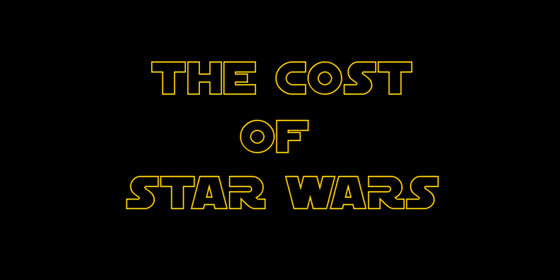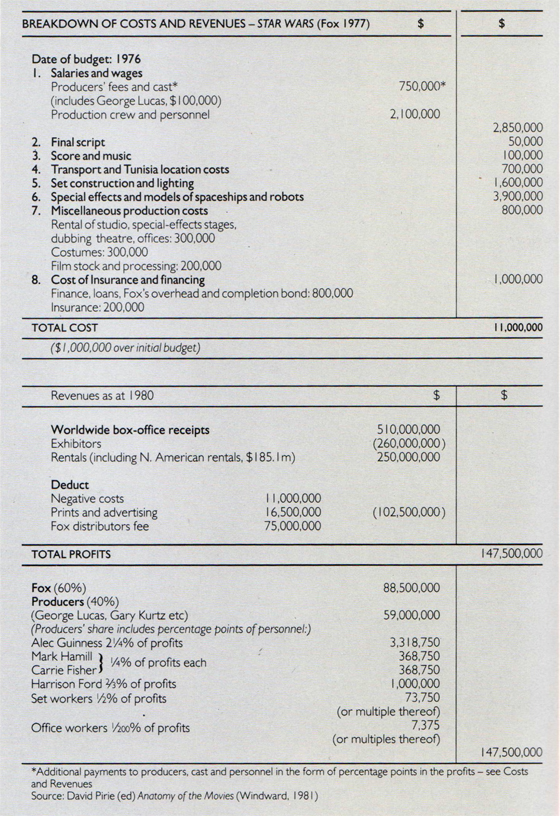How much did Star Wars (1977) cost to make?
A quick Wikipedia search tells us that the budget was $11m.
But what if we wanted to dig a little deeper?
Browsing an old bookstore, I came across Joel Finler’s The Hollywood Story which reprinted a breakdown of the Star Wars budget.
This in itself was reprinted from David Pirie’s Anatomy of the Movies, which in turn was presuambly sourced from a 20th Century Fox or Lucasfilm financial statement.
It is worth noting that these figures would have been from 1980 – before the dollars from home video and merchandising really began to flow.
[Click here for a larger version]
There are a few things that stand out:
- The Cost of the Visual Effects: Star Wars was effectively the birth of the modern visual effects industry and this can be seen by the unusually high budget for the ‘special effects and models of spaceships and robots’.
- The Transport and Tunisia Location Costs: The $700,000 it took to take the film to the North African desert paid off as early on in the film it gave it a sense of real world scope.
- World Wide Box Office Receipts: When this statement was published the figure of $510m was pretty spectacular, overtaking Jaws (1975) which ushered in the blockbuster era with $470m. Spielberg would regain the all-time box office crown with E.T. (1982) record-breaking $792m.
- The Negative Cost: When budgets are often quoted in the mainstream press, the figure usually being discussed its what’s called a ‘negative cost’ – the price it took to produce the finished negative of the movie. Here it was $11m, which actually tallies with the Wikipedia figure.
- Prints and Advertsing: This is the combined cost of producing the film prints, shipping them to cinemas around the world and then marketing the fact that the film is showing (outdoor posters, television spots etc). Traditionally the global profits are split 50/50 between studio and exhibitor, although it can vary. The typical exhibitor’s share in the US is split 45 to 55% and in the Rest of the World 55 to 65%. UK exhibitors often keep an unusually high amount, averaging around 65 to 70%. In the case of Star Wars the $510m was carved up between exhibitors ($260m) and the studio ($250m).
- Percentage Points: Fox, Lucasfilm and various actors accepted percentage points of the final profits. Fox took %60 ($88.5m) and the producers took %40 ($59m). Of that producer share several actors got unexpected bonuses. Chief among them was Alec Guinness (%2.75 or $3.3m), Mark Hamill (%0.25 or $368,750), Carrie Fisher (%0.25 or $368,750) and Harrison Ford (%0.33 or $1m), set workers (%0.5 or $73,750) and office workers (%0.02 or $$7,375)
As of 2008, the overall box office revenue generated by the six Star Wars films is around $4.41 billion.
Only the Harry Potter and James Bond franchises have grossed more.
Aside from making George Lucas a lot of money, their other creative legacy is the creation of ILM, the company founded to create the visual effects for the movies.
For example, the opening shot of Star Wars took eight months and Lucas wanted people who could use the power of computers to help make the process easier.
Lucas hired Ed Catmull, who was in charge of the computer division at Lucasfilm and Alvy Ray Smith, who became head of the graphics project there.
When Lucas sold this computer graphics division to Steve Jobs in 1986, the former Apple boss (who would eventually return in 1997) renamed the company Pixar.
It would eventually go on to make animation history with a series of pioneering short films, Toy Story (1995) and a series of Oscar-winning and box office triumphs.
But for more on that, story check out the history of Pixar.
> Star Wars at Wikipedia
> Skillset breakdown of film finances

